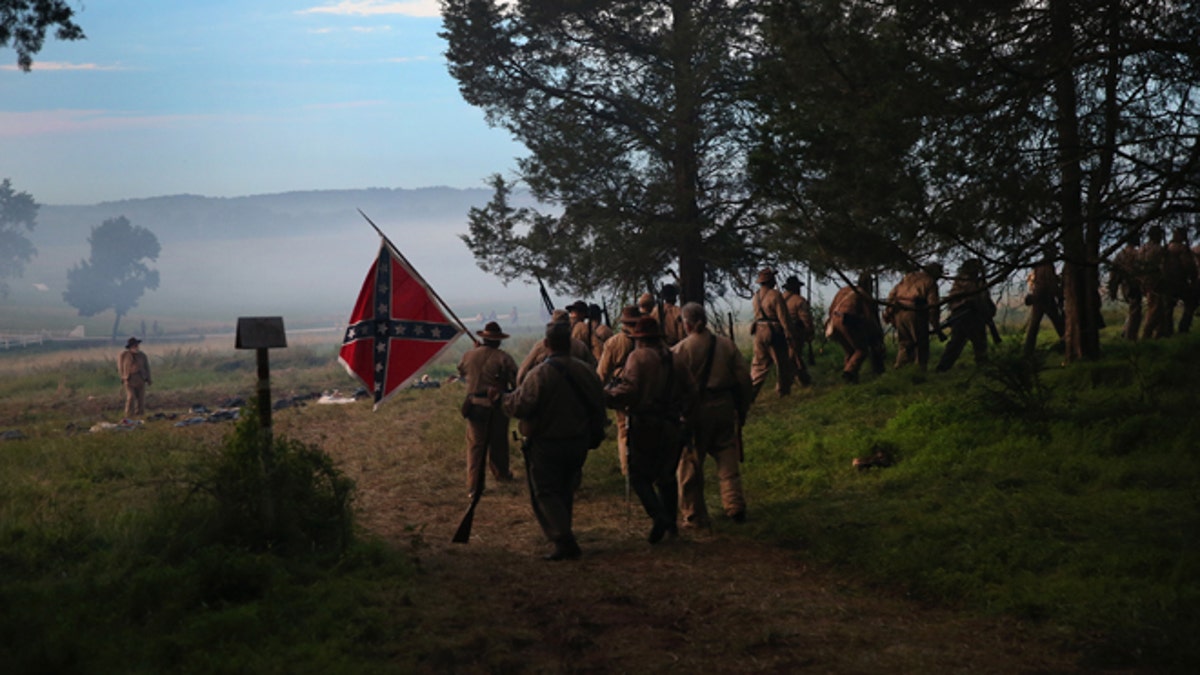
GETTYSBURG, PA - JUNE 29: Confederate Civil War re-enactors from Hood's Texas Brigade leave in defeat after an evening attack on Union troops as part of a three-day Battle of Gettysburg re-enactment on June 29, 2013 in Gettysburg, Pennsylvania. Some 8,000 re-enactors from the Blue Gray Alliance are participating in events marking the 150th anniversary of the July 1-3, 1863 Battle of Gettysburg. General Robert E. Lee's Army of Northern Virginia was defeated on the third day of the battle, considered the turning point in the American Civil War and a watershed moment in the nation's history. Union and Confederate armies suffered a combined total of some 46,000-51,000 casualties over three days, the highest of any battle the four-year war. (Photo by John Moore/Getty Images) (2013 Getty Images)
The American Civil War officially ended on April 9, 1865, when Gen. Robert E. Lee of the Confederacy surrendered to Union Gen. Ulysses S. Grant at Appomattox Court House in Virginia.
But news traveled slower in those days, and about a month after Appomattox, a two-day battle was fought on the banks of the Rio Grande. The Battle of Palmito Hill is generally regarded as the last major clash between the South and the North.
And, ironically, the South won.
Among the perhaps 1,000 soldiers involved, there were probably a number of Hispanics who fought for both sides.
According to Wilson Bourgeois, a historian with the Cameron Country Historical Commission, it was common to see Hispanics fighting in the Civil War, especially in the South.
- Best pix of the week
- The Right Stuff For War: Military Give Women A Taste Of Combat
- U.S. Military Cemetery in Mexico City
- Military Supplies Recycled For Fashionable Purpose
- Deported military veterans push to be included in executive action
- ‘Por Ellos, Si Podemos’ photo campaign celebrates Hispanic heroes
- We Salute These Hispanic Trailblazers
The earliest record of Tejanos – meaning Texans, which had only joined the United States in 1845, who were of Mexican descent – and Mexicans enlisting into the service was 1861, when the last names Chavez and Gonzalez began popping up in the rolls of Hood’s Texas Brigade, Bourgeois said.
“They literally fought in every date that you can think of,” he told Fox News Latino on the anniversary of the Palmito Hill. “Tejanos fought for the Confederacy and Texas furiously.”
He said the reason Hispanics took part varied from person-to-person, as it did for whites and former slaves. Many, Bourgeois said, joined up because of the $13-a-day pay. On top of that, they received new clothes and got three hot meals a day.
“It was a pretty good thing (for many men),” said Bourgeois, who is himself of Mexican-American heritage.
At Palmito Hill, the number of Hispanics fighting for the Confederacy is unconfirmed, but because the 2nd Texas Calvary Regiment was involved, Bourgeois believes there were a number.
“It was only until recently that we found documents (with the enlistments),” he said. “They are being currently prepared for viewing. The documents are so old, and the paper is extremely fragile.”
“From my research, of the 2nd Texas, 46 were Tejanos,” he added.
The battle, on May 12-13, was fought on land where little has changed in 150 years, marked chiefly by patches of prickly pear cactuses, void of the hill's namesake palm trees and buffeted periodically over the decades by storm surges and hurricanes.
"You don't just come here," Craig Stone, of the Cameron County Historical Commission, told the Associated Press. "You have to want to be here."
Ignoring an informal truce that had been imposed months before, Union Col. Theodore Barrett launched a surprise, unsanctioned attack in an attempt to capture Brownsville. Confederate Col. John Salmon “Rip” Ford, who had been present when the truce was agreed on, didn’t back down from the fight.
“The battle was so insignificant at this time,” Bourgeois said, because Lee had already surrendered, Confederate President Jefferson Davis had been captured two days prior and Abraham Lincoln had been assassinated on Apr. 15. “(But) both sides wanted the valley.”
Ford’s men fought back hard.
"Boys, we have done well," Ford told his men, according to his memoirs, housed at the Briscoe Center for American History at the University of Texas. "If memory is correct, the federals had about 50 killed and wounded, and 113 prisoners," he wrote. "Our loss a small number wounded."
Among the casualties, was Union Pvt. John J. Williams, from the 34th Indiana, who is considered by historians to be the last combatant killed in a war that claimed more than 600,000 soldiers' lives.
Today, a water tower about 15 miles to the west of the battlefield is the only hint at civilization, in contrast to the historic shrines that can be found at places like Fort Sumter National Monument in Charleston, South Carolina, where the war began and in Gettysburg, Pennsylvania, where the tide of the war turned.
“It never really got the credit it deserves or the importance,” Stone told the Associated Press. “They were still fighting. What did they have to gain?”
The Cameron Country Civil War Sesquicentennial Committee held an anniversary ceremony at the battlefield on Tuesday.
“We really tried to get more people interested in the history,” Bourgeois said. “The contribution of the Tejanos for both sides ... should be remembered. These men fought, bled and some died to make this country what it is. Their contribution was powerful.”
The Associated Press contributed to this report.
